Water Extractable Arabinoxylan Aerogels Prepared by Supercritical CO2 Drying
Abstract
:1. Introduction
2. Results and Discussion
2.1. Extraction and Characterization of WEAX
| Component | Content |
|---|---|
| Arabinose a | 27.00 ± 1.10 |
| Xylose a | 40.00 ± 0.40 |
| Glucose a | 5.30 ± 0.30 |
| Protein a | 4.70 ± 0.01 |
| Ferulic acid b | 0.530 ± 0.001 |
| Diferulic acids b | 0.040 ± 0.002 |
2.2. WEAX Hydrogel
2.3. WEAX Aerogel
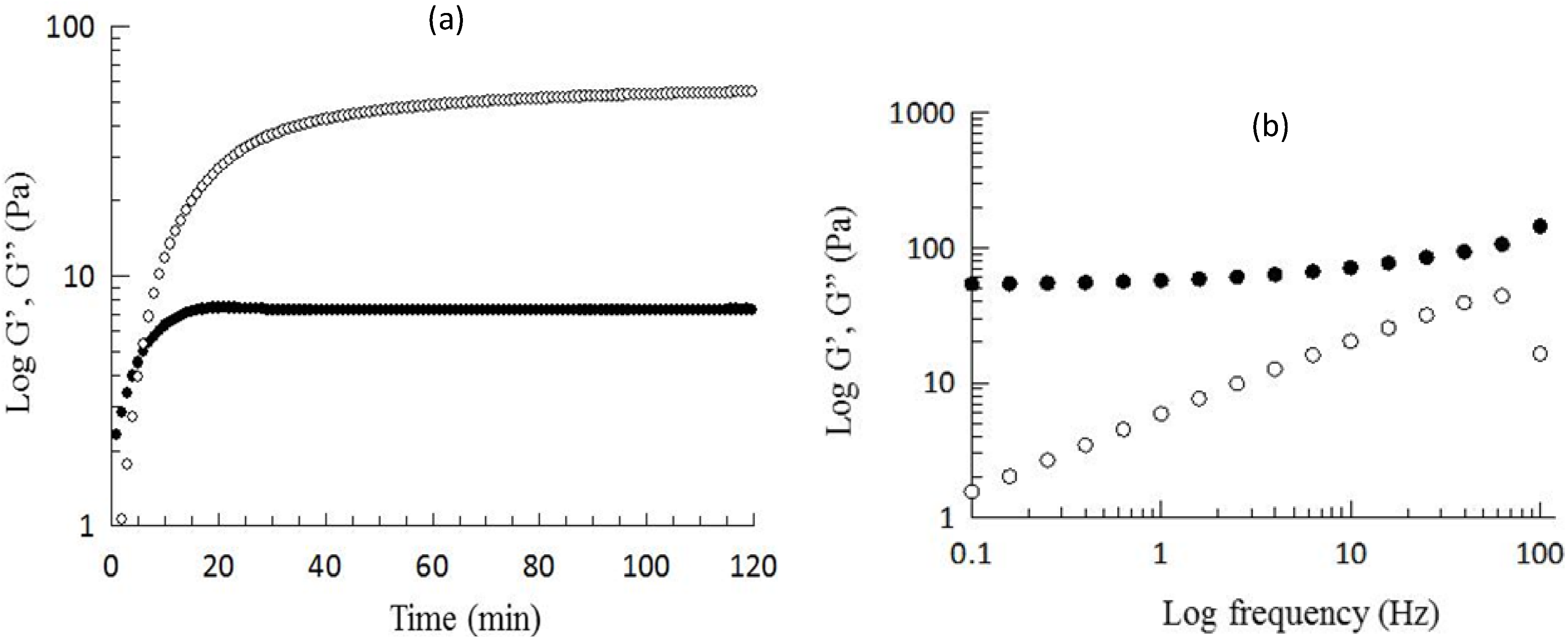
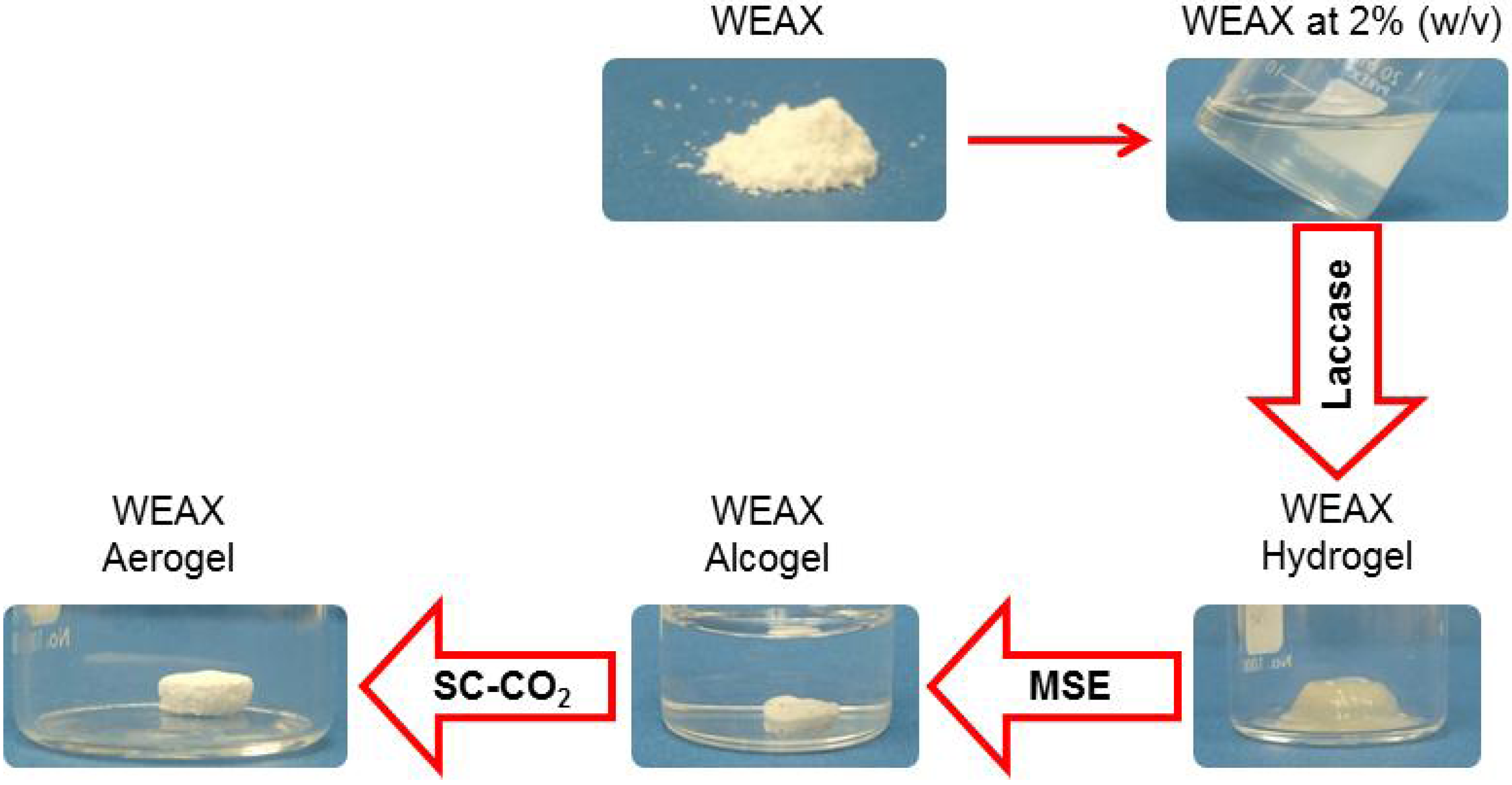
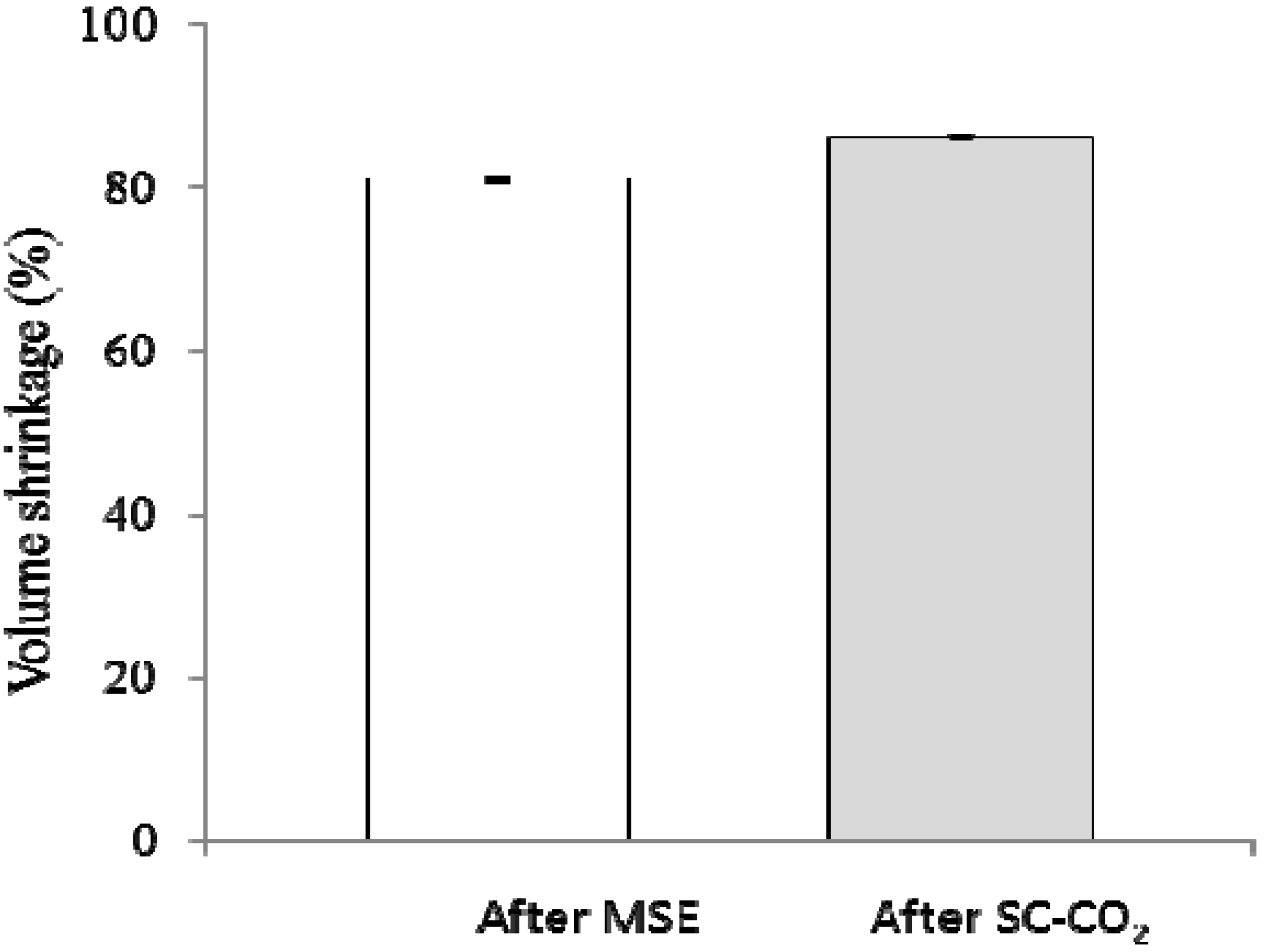
2.4. Microscopy and Texture of WEAX Aerogel
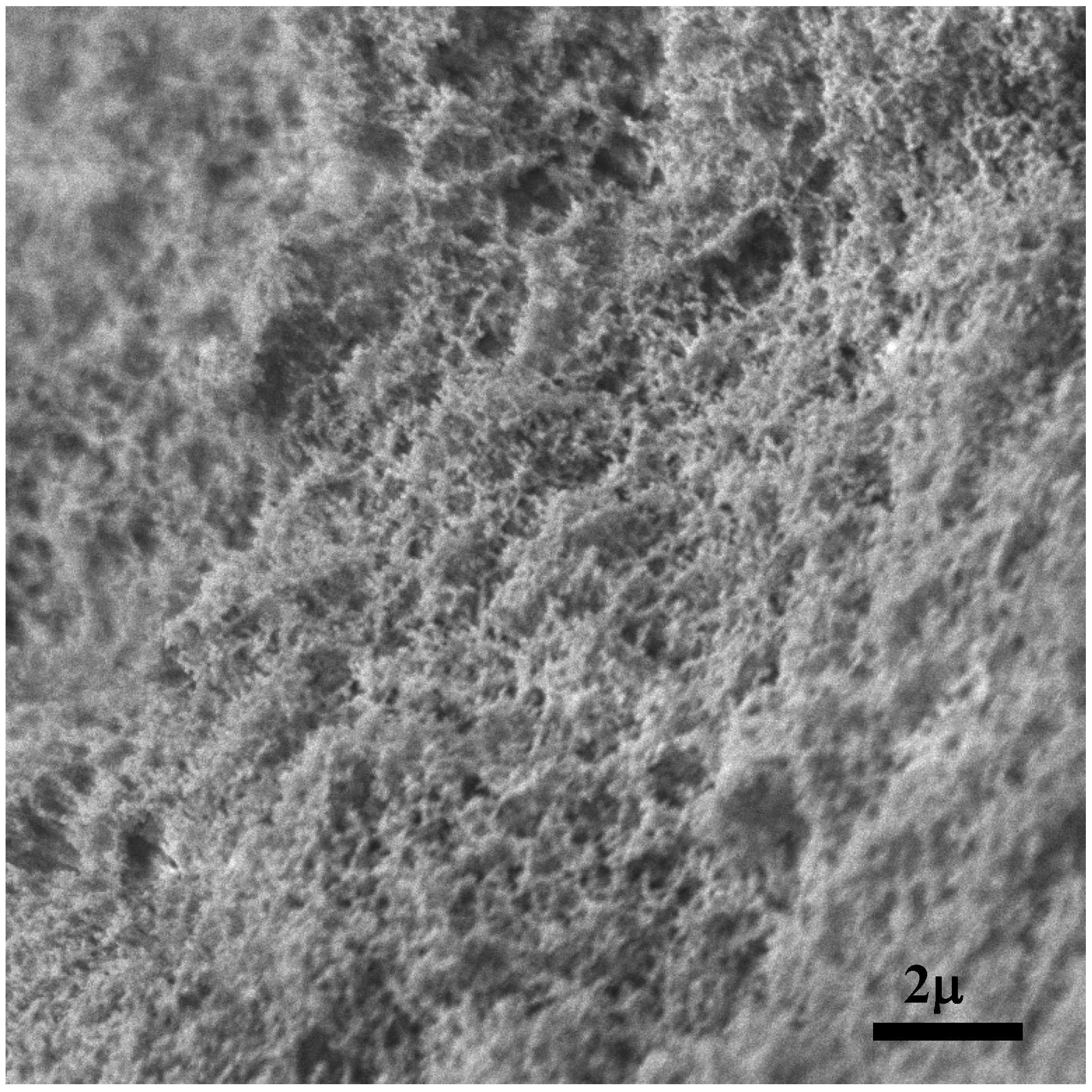

| Textural property | Value |
|---|---|
| Pore volume, Vp (cm3/g) | 0.30 |
| Average mesopore diameter, Pd (nm) | 2.20 |
| Surface area, Sa (m2/g) | 53.70 |
2.5. Rehydration of WEAX Aerogel
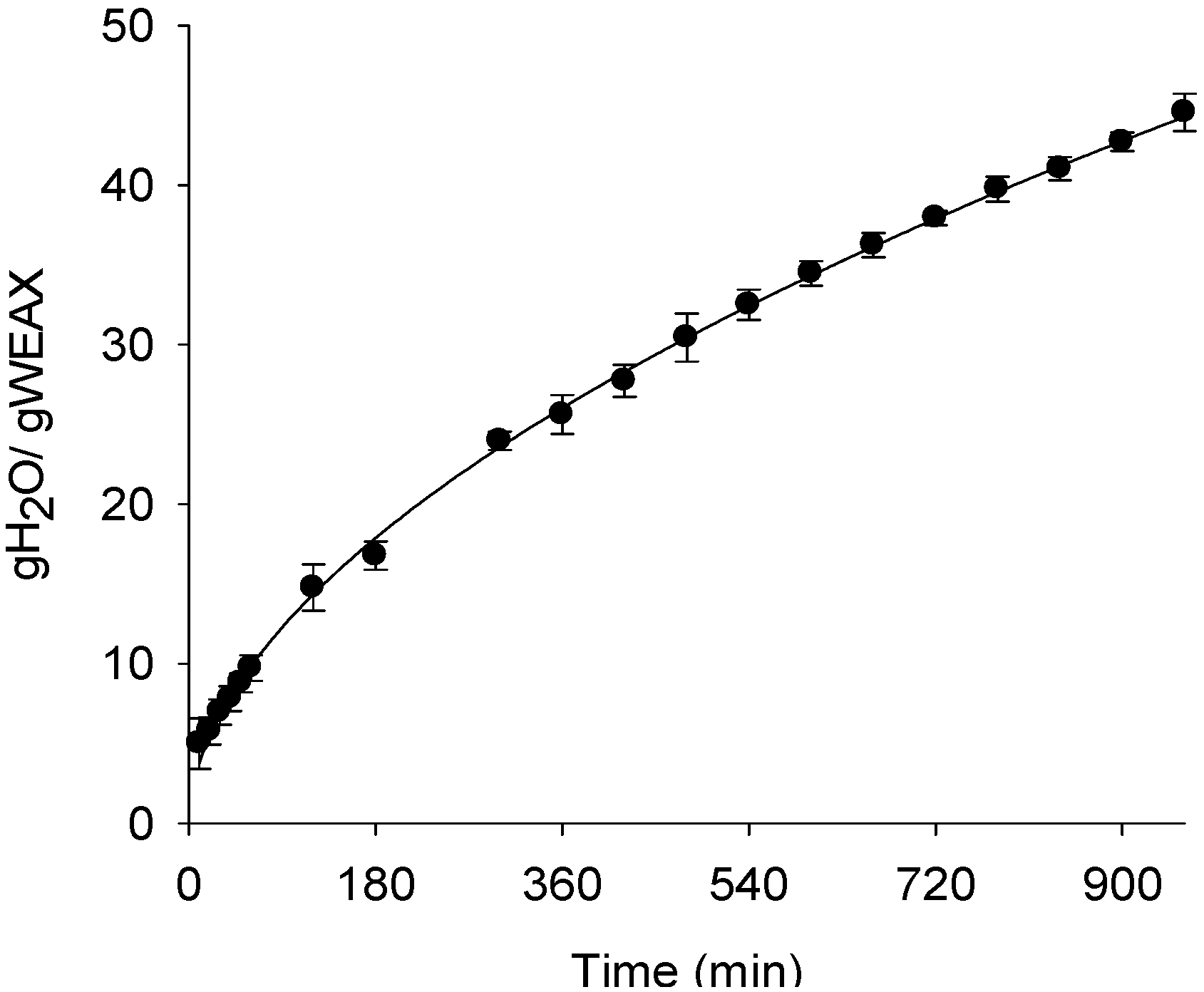
| Parameter | Value |
|---|---|
| k | 1.07 ± 0.10 |
| n | 0.54 ± 0.01 |
| r2 | 0.99 |
3. Experimental
3.1. Materials
3.2. Methods
3.2.1. WEAX Characterization
3.2.2. WEAX Hydrogel
3.2.3. WEAX Aerogel
3.2.4. Microscopy and Textural Analysis of WEAX Aerogel
3.2.5. WEAX Aerogels Rehydration
3.2.6. Statistical Analysis
4. Conclusions
Acknowledgments
Conflicts of Interest
References
- Smirnova, I.; Mamic, J.; Arlt, W. Adsorption of drug on silica aerogels. Langmuir 2003, 19, 8521–8525. [Google Scholar]
- Akimov, Y.K. Fields of applications of aerogels. Instrum. Exp. Tech. 2003, 46, 287–299. [Google Scholar] [CrossRef]
- Hüsing, N.; Schubert, U. Aerogels—Airy materials: Chemistry, structure, and properties. Angew. Chem. Int. Ed. Engl. 1998, 37, 22–45. [Google Scholar] [CrossRef]
- Pierre, A.C.; Pajonk, G.M. Chemistry of aerogels and their applications. Chem. Rev. 2002, 102, 4243–4265. [Google Scholar] [CrossRef]
- Elghniji, K.; Ksibi, M.; Elaloui, E. Sol-gel reverse micelle preparation and characterization of N-doped TiO2: Efficient photocatalytic degradation of methylene blue in water under visible light. J. Ind. Eng. Chem. 2012, 18, 178–182. [Google Scholar] [CrossRef]
- Moussaoui, Y.; Elaloui, E.; Salem, R.B. Étude mécanistique et structurale des résines R/F. Mechanistic and structural study of R/F resins. Comptes Rendus Chimie 2012, 15, 493–498. [Google Scholar] [CrossRef]
- Zwega, A.; Elalouia, E.; Nouria, S.; Moussaouib, Y. Optimization of the synthesis based on Resorcine and formaldehyde to obtain carbon nanoxerogels. Mater. Sci. Eng. 2012, 27, 12034. [Google Scholar]
- Mnasri, N.; Moussaoui, Y.; Elaloui, E.; ben Salem, R.; Lagerge, S.; Douillard, J.M.; de Menorva, L.C. Study of interaction between chitosan and active carbon in view of optimizing composite gels devoted to heal injuries. EPJ Web of Conferences 2012, 29, 00028. [Google Scholar]
- Huang, H.J.; Chen, X.D.; Yuan, W.K. Microencapsulation based on emulsification for producing pharmaceutical products: A literature review. Dev. Chem. Eng. Miner. Process. 2006, 14, 515–544. [Google Scholar] [CrossRef]
- Domb, A.J.; Kost, J. Handbook of Biodegradable Polymers; Harwood Academic Publishers: Amsterdam, The Netherlands, 1997; pp. 273–290. [Google Scholar]
- Izydorczyk, M.S.; Biliaderis, C.B. Cereal arabinoxylans: Advances in structure and physicochemical properties. Carbohydr. Polym. 1995, 28, 33–48. [Google Scholar] [CrossRef]
- Smith, M.M.; Hartley, R.D. Occurrence and nature of ferulic acid substitution of cell-wall polysaccharides in graminaceous plants. Carbohydr. Res. 1983, 188, 65–80. [Google Scholar] [CrossRef]
- Vansteenkiste, E.; Babot, C.; Rouau, X.; Micard, V. Oxidative gelation of feruloylated arabinoxylan as affected by protein. Influence on protein enzymatic hydrolysis. Food Hydrocolloid. 2004, 18, 557–564. [Google Scholar] [CrossRef]
- Carvajal-Millan, E.; Stéphane, G.; Doublier, J.L.; Micard, V. Arabinoxylan/protein gels: Structural, rheological and controlled release properties. Food Hydrocoll. 2006, 20, 53–61. [Google Scholar]
- Berlanga-Reyes, C.M.; Carvajal-Millan, E.; Lizardi-Mendoza, J.; Rascón-Chu, A.; Marquez-Escalante, J.A.; Martínez-López, A.L. Maize arabinoxylan gels as protein delivery matrices. Molecules 2009, 14, 1475–1482. [Google Scholar] [CrossRef]
- Carvajal-Millan, E.; Guigliarelli, B.; Belle, V.; Rouau, X.; Micard, V. Storage stability of laccase induced arabinoxylan gels. Carbohydr. Polym. 2005, 59, 181–188. [Google Scholar] [CrossRef]
- Carvajal-Millan, E.; Guilbert, S.; Morel, M.H.; Micard, V. Impact of the structure of arabinoxylan gels on their rheological and protein transport properties. Carbohydr. Polym. 2005, 60, 431–438. [Google Scholar] [CrossRef]
- Saulnier, L.; Sado, P.E.; Branlard, G.; Charmet, G.; Guillon, F. Wheat arabinoxylans: Exploiting variation in amount and composition to develpop enhanced varieties. J. Cereal Sci. 2007, 46, 261–281. [Google Scholar] [CrossRef]
- Carvajal-Millan, E.; Landillon, V.; Morel, M.H.; Rouau, X.; Doublier, J.L.; Micard, V. Arabinoxylan gels: Impact of the feruloylation degree on their structure and properties. Biomacromolecules 2005, 6, 309–317. [Google Scholar]
- Clark, A.H. Gels and gelling. In Physical Chemistry of Foods; Schwartzberg, H.G., Hartel, R.W., Eds.; Marcel Dekker Publishers: New York, NY, USA, 1992; p. 263. [Google Scholar]
- Carvajal-Millan, E.; Rascón-Chu, A.; Márquez-Escalante, J.A.; Micard, V.; Ponce de León, N.; Gardea, A. Maize bran gum: Extraction, characterization and functional properties. Carbohydr. Polym. 2007, 69, 280–285. [Google Scholar]
- Mehling, T.; Smirnova, I.; Guenther, U.; Neubert, R.H.H. Polysaccharide-based aerogels as drug carriers. J. Non Cryst. Solids 2009, 355, 2472–2479. [Google Scholar]
- Smirnova, I.; Arlt, W. Synthesis of silica aerogels: Influence of the supercritical CO2 on the sol-gel process. J. Sol Gel Sci. Tech. 2003, 28, 175–184. [Google Scholar] [CrossRef]
- Alnaief, M. Process Development for Production of Aerogel with Controlled Morphology as Potential Drug Carrier Systems. Ph.D. Dissertation, Technische Universität Hamburg-Harburg, Hamburg, Germany, 2011. [Google Scholar]
- Jin, H.; Nishiyama, Y.; Wada, M.; Kuga, S. Nanofibrilla cellulose aerogels. Colloids Surf. A Physiclchem. Eng. Asp. 2004, 240, 63–67. [Google Scholar] [CrossRef]
- Cardea, S.; Pisanti, P.; Reverchon, E. Generation of chitosan nanoporous structures for tissue engineering applications using a supercritical fluid assisted process. J. Supercrit. Fluids. 2010, 54, 290–295. [Google Scholar] [CrossRef]
- Robitzer, M.; Tourrete, A.; Horga, R.; Velentin, R.; Boissière, M.; Devoisselle, J.M.; di Renzo, F.; Quignard, F. Nitrogen sorption as a tool the characterization of polysaccharides aerogels. Carbohyd. Polym. 2011, 85, 44–53. [Google Scholar] [CrossRef] [Green Version]
- Iravani, S.; Fitcher, C.S.; Georget, M.R. Physical characterization of arabinoxylan powder and its hydrogel containing a methyl xanthine. Carbohydr. Polym. 2011, 85, 201–207. [Google Scholar] [CrossRef]
- Alonso, G.; Berhault, G.; Aguilar, A.; Collins, V.; Ornelas, C.; Fuentes, S.; Chianelli, R.R. Characterization and HDS activity of mesoporous MoS2 catalysts prepared by in situ activation of tetraalkylammonium thiomolybdates. J. Catal. 2002, 208, 359–369. [Google Scholar] [CrossRef]
- Sing, K.S.W.; Everett, D.H.; Haul, R.A.W.; Moscou, L.; Pierotti, R.A.; Rouquerol, J.; Siemieniewska, T. Reporting physisorption data for gas/solid systems with special reference to the determination of surface area and porosity. Pure Appl. Chem. 1985, 57, 603–619. [Google Scholar] [CrossRef]
- Garcia-Gonzalez, C.A.; Alnaief, M.; Smirnova, I. Polysaccharide-based aerogels-promising biodegradable carriers for drug delivery systems. Carbohydr. Polym. 2011, 86, 1425–1438. [Google Scholar] [CrossRef]
- Tsioptsias, C.; Michailof, C.; Stauropoulos, G.; Panayiotou, C. Chitin and carbon aerogels from chitin alcogels. Carbohydr. Polym. 2009, 76, 535–540. [Google Scholar] [CrossRef]
- Comin, L.M.; Temelli, F.; Saldana, M.D.A. Barley beta-glucan aerogels via supercritical CO2 drying. Food Res. Inter. 2012, 48, 442–448. [Google Scholar] [CrossRef]
- Robitzer, M.; di Renzo, F.; Quignard, F. Natural materials with high surface area. Physisorption methods for the characterization of the texture and surface of polysaccharide aerogels. Microporous Mesoporous Mater. 2011, 140, 9–16. [Google Scholar] [CrossRef]
- Meyvis, T.K.L.; de Smedt, S.C.; Demeester, J.; Hennink, W.E. Influence of the degradation mechanism of hydrogels on their elastic and swelling properties during degradation. Macromolecules 2000, 33, 4717–4725. [Google Scholar] [CrossRef]
- The Association of Official Analytical Chemists (AOAC). Official Methods of Analysis, 1st supplement; AOAC: Arlington, VA, USA, 1990.
- Brunauer, S.; Emmett, P.H.; Teller, E. Adsorption of gases in multimolecular layers. J. Am. Chem. Soc. 1938, 60, 309–319. [Google Scholar] [CrossRef]
- Peppas, N.A. Analysis of Fickian and non-Fickian drug release from polymers. Phram. Acta Helv. 1985, 60, 110–111. [Google Scholar]
- Sample Availability: Not available.
© 2013 by the authors; licensee MDPI, Basel, Switzerland. This article is an open access article distributed under the terms and conditions of the Creative Commons Attribution license (http://creativecommons.org/licenses/by/3.0/).
Share and Cite
Marquez-Escalante, J.; Carvajal-Millan, E.; Miki-Yoshida, M.; Alvarez-Contreras, L.; Toledo-Guillén, A.R.; Lizardi-Mendoza, J.; Rascón-Chu, A. Water Extractable Arabinoxylan Aerogels Prepared by Supercritical CO2 Drying. Molecules 2013, 18, 5531-5542. https://doi.org/10.3390/molecules18055531
Marquez-Escalante J, Carvajal-Millan E, Miki-Yoshida M, Alvarez-Contreras L, Toledo-Guillén AR, Lizardi-Mendoza J, Rascón-Chu A. Water Extractable Arabinoxylan Aerogels Prepared by Supercritical CO2 Drying. Molecules. 2013; 18(5):5531-5542. https://doi.org/10.3390/molecules18055531
Chicago/Turabian StyleMarquez-Escalante, Jorge, Elizabeth Carvajal-Millan, Mario Miki-Yoshida, Lorena Alvarez-Contreras, Alma Rosa Toledo-Guillén, Jaime Lizardi-Mendoza, and Agustín Rascón-Chu. 2013. "Water Extractable Arabinoxylan Aerogels Prepared by Supercritical CO2 Drying" Molecules 18, no. 5: 5531-5542. https://doi.org/10.3390/molecules18055531





